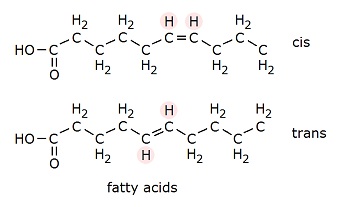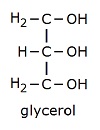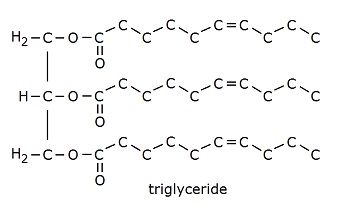|
Fats
Fats store energy in a more concentrated form than carbohydrate. They do this by leaving out oxygen, which is low in energy, and attaching hydrogen to carbon atoms instead. Without oxygen, fats don't dissolve in water. Oxygen is what makes carbohydrates water soluble.
There are often double bonds in various places along the chains, which increase the tendency to form a liquid as an oil. The double bonds can form at different angles, which is strictly controlled by enzymes. If the double bonds leave hydrogen on the same side, the configuration is called cis. If the hydrogens are opposite each other, the configuration is called trans. These chains are called fatty acids, because they have an acid group attached to the end. The universal acid in biochemistry is the equivalent of a carbon dioxide molecule attached to another carbon atom. This causes a hydrogen to attach to one of the oxygens. The hydrogen can easily be released, which is what an acid does. The reason why the fats have an acid group on them is so they can easily be linked together in groups of three. They attach to glycerol to do this. The resulting aggregate is called a triglyceride. This image leaves out the hydrogens for easier viewing. Fats weren't exactly a space-saving concept. They were an exploit of the fact that the breakdown of glucose leaves two-carbon compounds. Normally, these are channeled through the TCA system to be broken down into carbon dioxide while channeling the resulting energy into the respiratory system. Yeasts, however, diverted the metabolism in a different direction. They needed to use sugars as fast as possible to keep them away from competitors. So they shut down (repress) their TCA systems when sugars are available and converted some of the two-carbon compounds into alcohol and some into acetic acid, both of which are excreted to ward off competitors. After yeasts run out of sugars, they re-metabolize the acid and alcohol through the TCA system, which they synthesis after sugars are depleted. But this adaptation still wasn't good enough, because yeasts can only produce so much acid and alcohol before it becomes toxic to themselves. So they linked some of the acetic acid molecules together and stored them as fats. Other organisms would not have gone through this process of evolution, because they do not shut down their TCA systems. What this adds up to is that fat production must have evolved in yeasts only, and then the mechanism was transferred from yeasts to other organisms. This concept would have been unthinkable a few decades ago, when all evolution was assumed to follow lines of decent from parents to offspring. But a new mechanism has since been discovered, where genes are carried between species through vectors such as viruses. What used to be viewed as convergence of evolution is probably totally due to horizontal transfer of genes through vectors, as demanding evolution would not likely go through the same process twice. Only very unusual circumstances allow complex evolution. Those circumstances would not occur twice.
|


